How to scale a startup: the ultimate guide
 Artsem
Artsem
The success or failure of your startup depends on your ability to grow and adapt to changing market conditions. Scaling is not just about adding more customers, employees, or revenue. It's about building a sustainable business model that can withstand the challenges of rapid growth.
In this article, we'll explore the importance of scaling a startup and provide practical advice on how to navigate the ups and downs of growth including real-world examples from various startup founders.
Whether you're a seasoned entrepreneur or a first-time founder, the insights and strategies in this article will help you take your startup to the next level. So, buckle up and get ready for the ride of your life! 🎢
What is startup scaling?
Startup scaling refers to the process of growing a business beyond its current stage to achieve sustainable and rapid growth. It involves increasing the number of customers, employees, and revenue while maintaining or improving profitability.
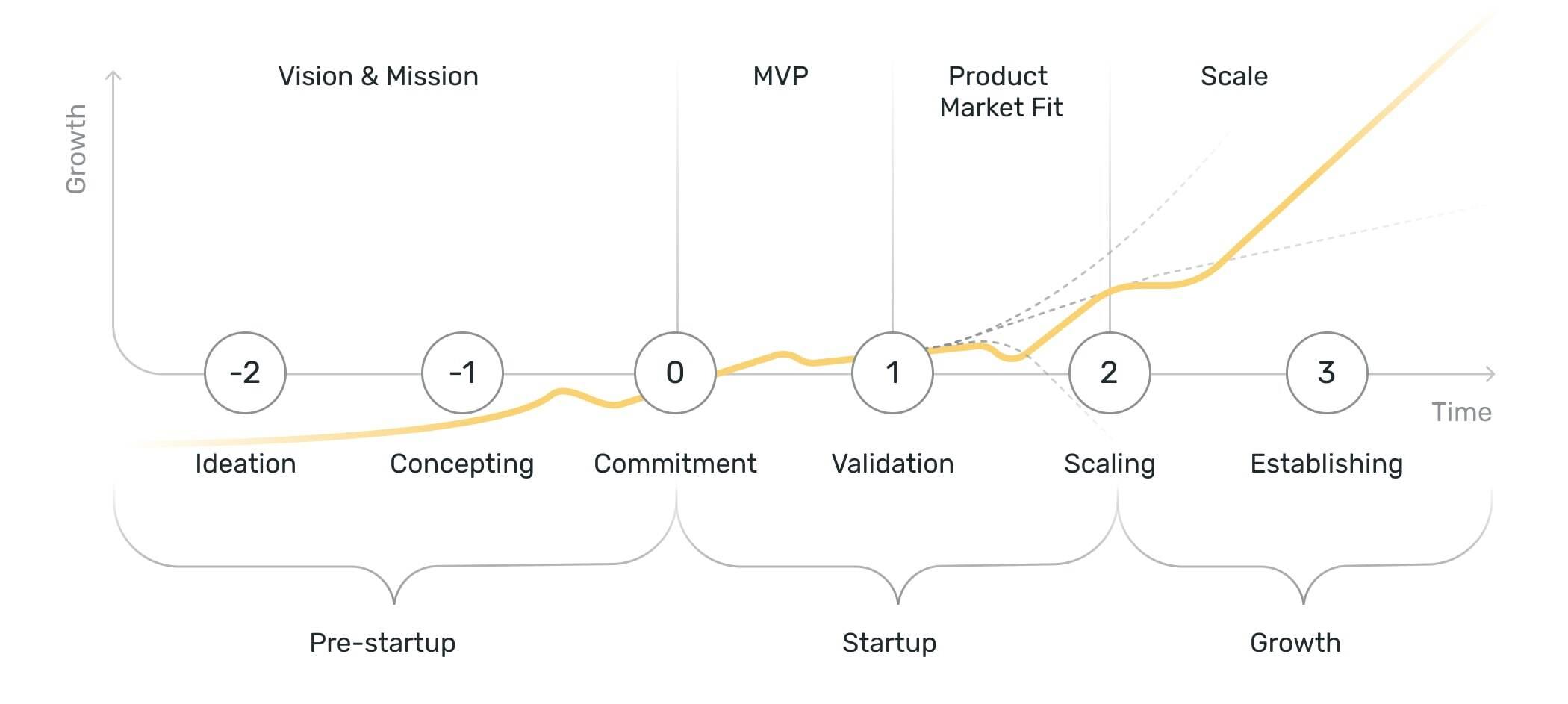
Scaling a startup is a critical phase for entrepreneurs and investors because it determines the long-term success of a business. To scale a startup successfully, founders must develop a scalable business model, secure funding, hire and train the right talent, and build a culture that supports growth.
Effective and sustainable growth requires careful planning, execution, and continuous monitoring of key performance indicators (KPIs). When done successfully, startup scaling leads to long-term success which includes increased market share, higher valuations, and strong competitive advantage.
When a startup is ready for scaling?
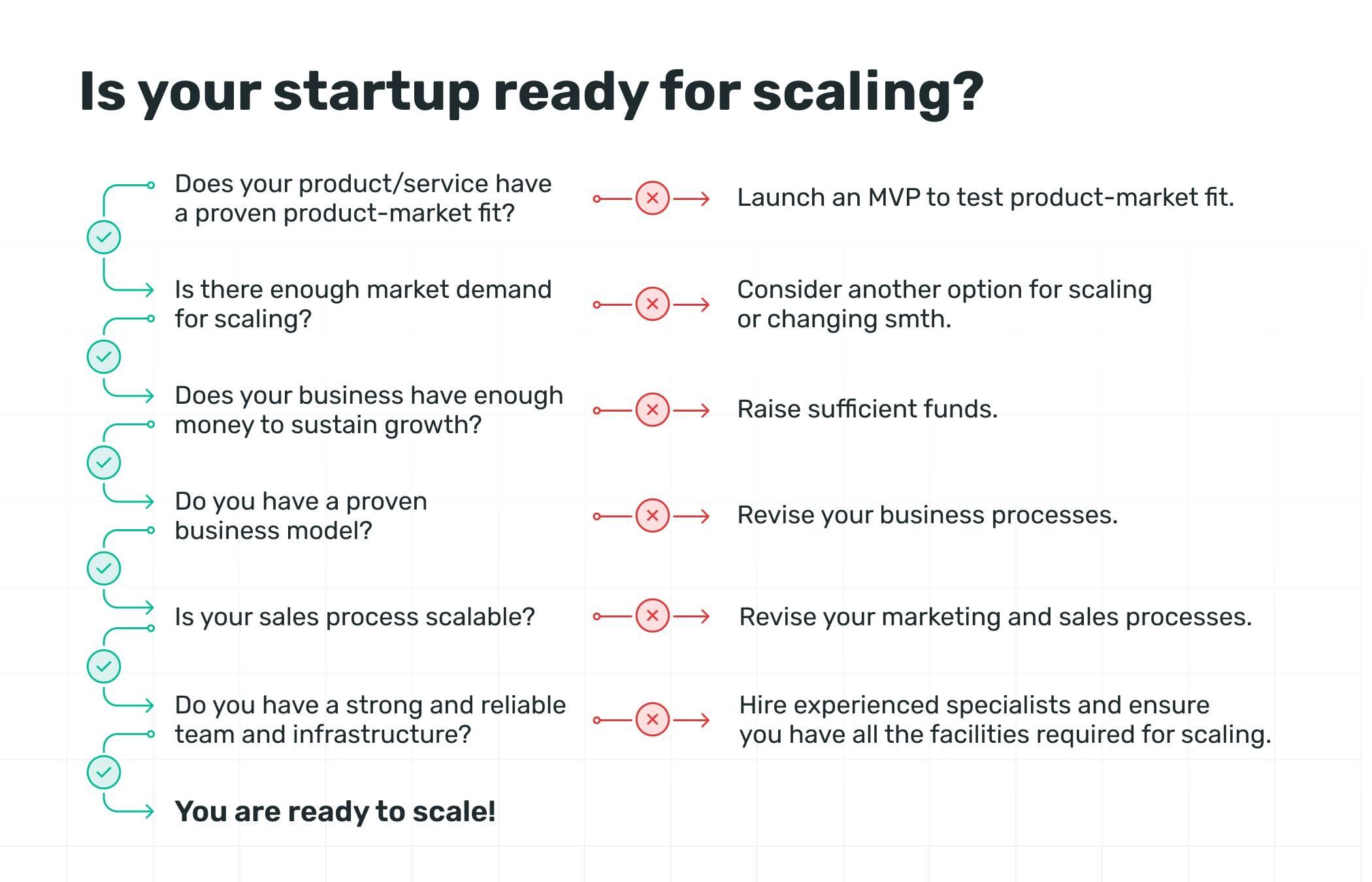
Determining if you are ready for startup scaling depends on a range of factors. Here are some key indicators that may suggest a startup is ready to scale:
- Established product-market fit. Before a startup can scale, it needs a developed MVP (Minimum Viable Product) or service that solves a real problem for its target market. You should have an understanding that there is a clear demand for the product or service.
“The solution that you want to build has to first work in an Excel sheet. That was my biggest mistake with Jobbatical 1.0 - we started to build a product based on my idea, but the market had not validated the actual need for such a solution.
With Jobbatical 2.0 we started to build it since it became unmanageable in a spreadsheet, and we started to automate different tasks that were done by humans. You must be able to prove the value proposition first in an unscalable way and only then start to scale it.“
— Karoli Hindriks, CEO and founder of Jobbatical
Market demand and opportunity. You should have an understanding of the potential market size and strategies to capitalize on this opportunity.
Sufficient funding. This may include venture capital funding, angel investment, or other sources of funding that can support your startup growth objectives.
Proven business model. It is crucial to have a comprehensive understanding of your revenue sources, expenditures, and overall profitability.
Repeatable sales process. This means that you should have a clear understanding of your ideal customer profile and effective marketing and sales strategies that can be replicated and scaled.
Strong team and infrastructure. Your team should have the skills and experience needed to support growth. You should also make sure the required infrastructure, systems, and processes are in place to support increased demand.
By meeting these criteria, startups can position themselves for successful scaling and growth.
Startup scaling challenges
Scaling a startup can be an exciting and rewarding process, but it also comes with many challenges. Below, we described some of the main challenges startups face when scaling so you are aware of them and can address them accordingly.
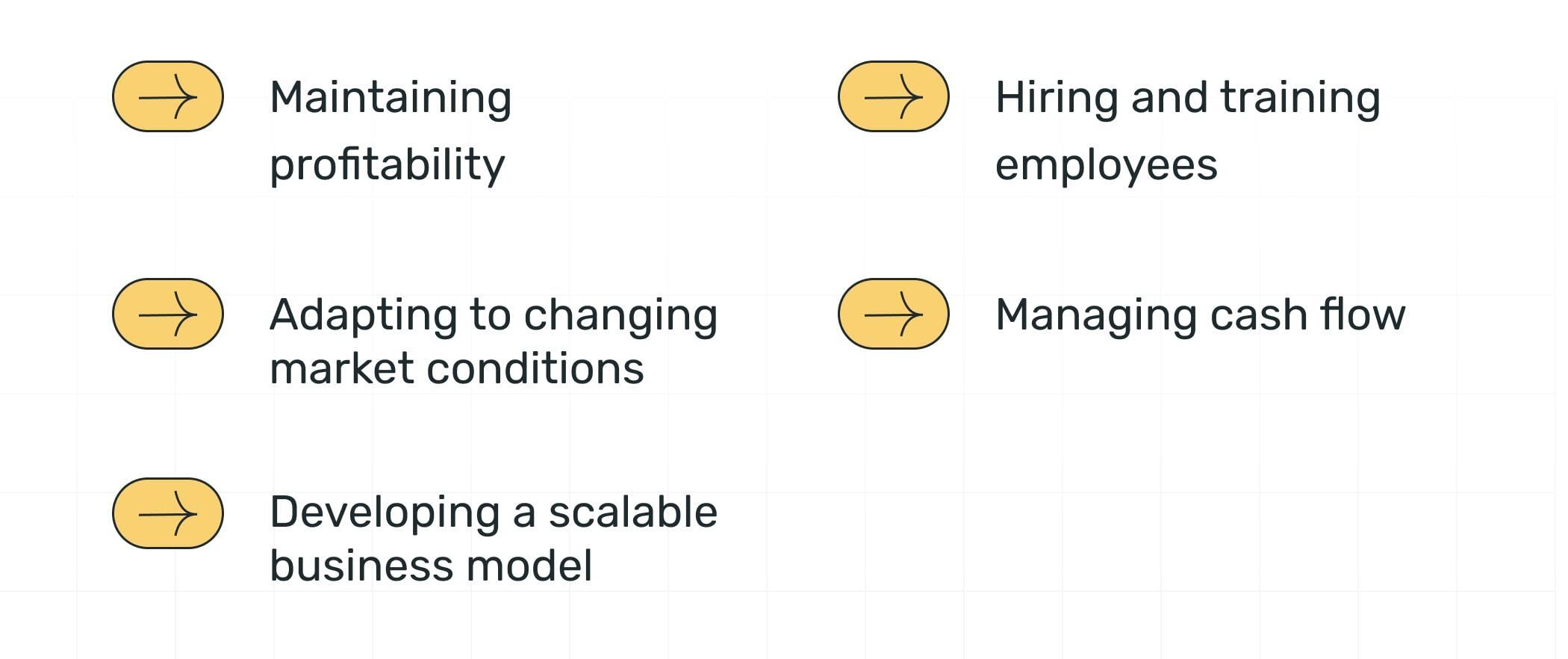
1. Maintaining profitability
One of the biggest challenges of startup scaling is maintaining profitability while increasing revenue. As the startup grows, it may need to invest in new equipment, technology, or talent, which can increase costs. At the same time, it may face pressure to keep prices low to remain competitive. Balancing these competing demands can be a difficult challenge for startups.
Example One example of a startup struggling to maintain profitability during scaling is Blue Apron. The meal kit delivery service grew rapidly in its early years, but in 2017, it struggled with high costs and operational challenges. As a result, the company's stock price dropped, and it was forced to lay off employees and cut costs to remain competitive.
2. Managing cash flow
Rapid growth can put a strain on a startup's cash reserves, and if it's not managed carefully, it can lead to financial difficulties. Startups need to ensure they have enough cash on hand to cover expenses, pay their bills, and invest in growth opportunities.
Example The subscription beauty service Birchbox grew quickly since its foundation in 2014, but it also burned through cash at a rapid rate within several years. This led to a cash crunch in 2016, which forced the company to lay off employees and focus on cost-cutting measures.
3. Hiring and training employees
Scaling a startup often requires hiring additional employees. However, whether it's an appointment setter or a software developer, finding the right talent and ensuring they are trained properly can be a challenge.
“The most difficult challenge we faced was hiring and getting the right people in the right seats. It's easy to hire when you're consistently bringing in new business, but if that new business slows down, you can be overstaffed very quickly, and you never want to let good people go. So, you need to be very slow to hire until you're absolutely sure you need that role.”
— Joshua Rawe, Co-founder of eSpark
Example An example of a startup that struggled to hire and train employees during scaling is Airbnb. The vacation rental platform grew rapidly, but it also faced challenges in finding and training hosts to provide quality experiences for guests. To address this challenge, the company developed a comprehensive training program for hosts that helped to improve the hosting services.
4. Adapting to changing market conditions
Market conditions can change rapidly, and startups need to be able to adapt quickly to stay competitive. As the startup grows, it may need to pivot its business model, change its marketing strategies, or explore new markets. This requires a high degree of flexibility and agility, which can be challenging for startups that are used to operating in a more stable environment.
Example A good example of a startup that successfully adapted to changing market conditions during scaling is Slack. The team communication platform grew rapidly, but it also faced increasing competition from other messaging apps. To stay competitive, Slack invested in new features, such as integrations with other tools and voice and video calls, to differentiate itself from the competition.
5. Developing a scalable business model
Finally, startups need to develop a scalable business model that can support rapid growth. This means designing a business model that can be replicated and expanded without sacrificing quality or efficiency. This requires careful planning, market research, and testing to ensure the business model is viable and sustainable over the long term.
Example Blue Bottle Coffee, a specialty coffee chain, faced the challenge of maintaining the quality of its products as it expanded. To address this problem, the company developed a training program for baristas and invested in new equipment and technology to ensure consistent quality across all locations.
Startup growth strategies
Further, we’ll explain in detail 5 main strategies for startup scaling:
1. Raise funds
Moving to the next round of funding is a critical step for startups looking to scale their businesses. To do so successfully, startups need to demonstrate both their potential for growth and their ability to execute their plans.
One strategy for moving to the next round of funding is to focus on building a strong track record of growth and performance. This can involve investing in key areas like product development, customer acquisition, and marketing, while also maintaining a clear focus on profitability and financial sustainability.
Another important aspect of moving to the next round of funding is building relationships with potential investors and partners. This can involve attending networking events, building a strong online presence, and leveraging referrals from existing investors or advisors.
One successful example of this strategy in action is the company Zoom, which raised $30 million in Series C funding in 2013 after demonstrating strong growth and a clear path to profitability. By focusing on building a strong user base and revenue stream, and leveraging partnerships with key enterprise clients, Zoom was able to attract a range of investors and secure the funding it needed to continue scaling its business.
Advantages of raising funds for scaling
Access to more resources
A broader network of contacts and potential partners
Increased credibility and visibility within the startup ecosystem
Drawbacks of raising funds for scaling
Increased pressure to meet growth targets
Greater scrutiny from investors
The risk of diluting existing equity
2. Invest in technology
Technology can help startups automate processes, streamline operations, and reach new customers more efficiently. To invest in technology effectively, startups need to understand their unique needs and identify the solutions that best support their scaling.
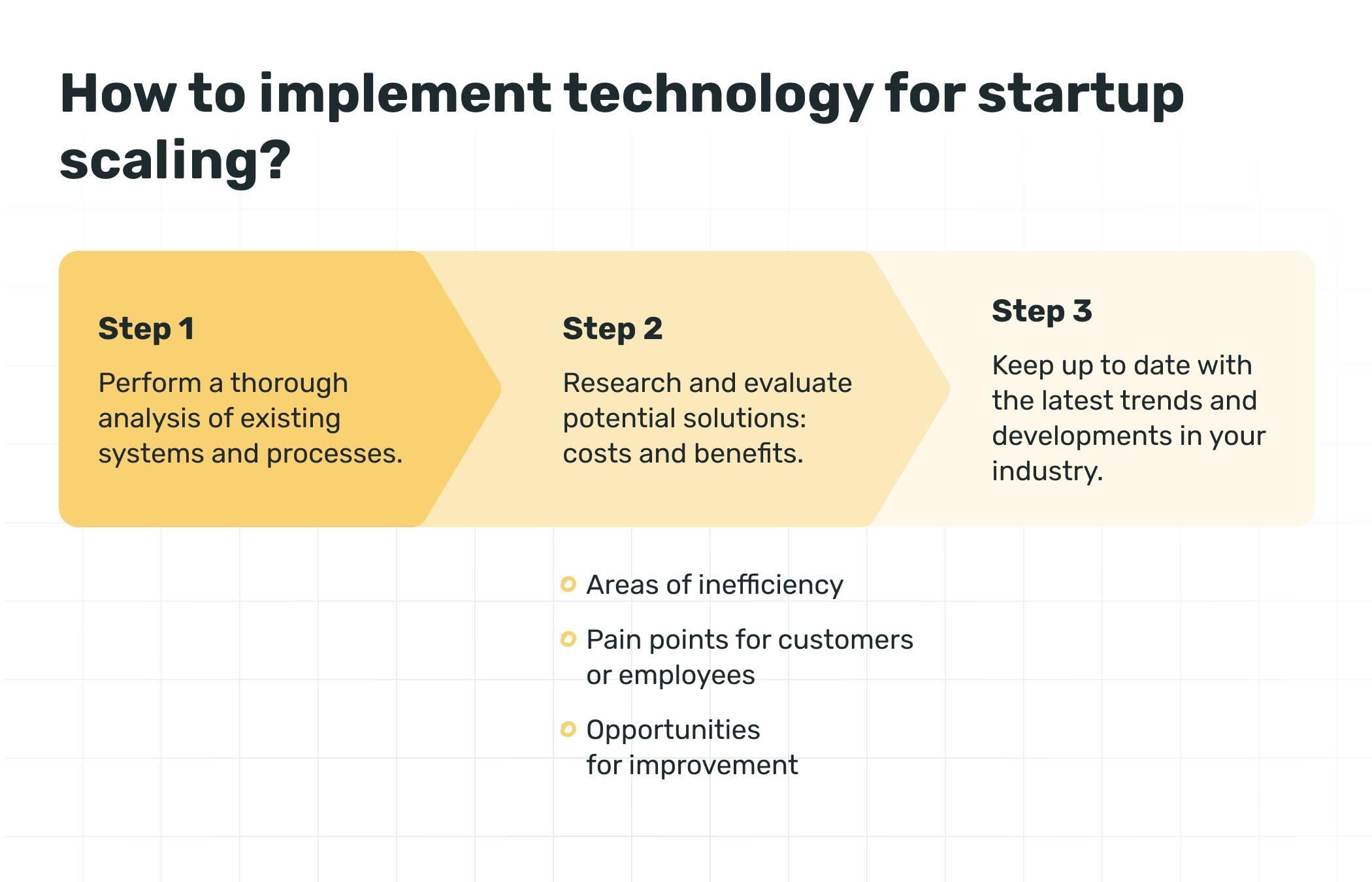
To implement this strategy effectively, you should perform a thorough analysis of existing systems and processes. This can involve identifying areas of inefficiency, pain points for customers or employees, and opportunities for improvement. From there, you can research and evaluate potential solutions, weighing the costs and benefits of each option.
Also, you should stay up-to-date with the latest trends and developments in your industry. This can involve attending industry events, reading industry publications, and building relationships with technology vendors and partners.
As for the examples, you know Slack, right? The company raised $427 million in Series H funding in 2018 after becoming one of the fastest-growing workplace software companies in history. Slack's success was driven in part by its innovative use of technology, including its intuitive user interface, powerful search capabilities, and robust integrations with other productivity tools.
Advantages of investing in technology
Increased efficiency
Improved customer experiences
Greater scalability and flexibility
Drawbacks of investing in technology
The risk of over-investing in technology that may not meet business needs
Security and data privacy concerns
3. Launch marketing campaign
Deploying a new marketing strategy can be a powerful way for startups to drive growth and scale their businesses. Whether it involves revamping an existing strategy or developing an entirely new one, a successful marketing strategy can help startups reach new customers, build brand awareness, and drive revenue.
Start by conducting a thorough analysis of the target market and the competition: identify key trends and pain points, and understand the competitive landscape and opportunities for differentiation.
From there, develop a comprehensive marketing plan that outlines the goals, tactics, and metrics for success. This can involve a range of activities, including search engine optimization (SEO), content marketing, social media marketing, email marketing, paid advertising, and other tools.
For example, Dollar Shave Club grew from a small startup to a billion-dollar company in just a few years by disrupting the traditional razor industry with a unique marketing strategy. They successfully leveraged social media, video marketing, and humor to build a strong brand identity and reach millions of customers.

“To scale our startup, we adopted rapid testing for various customer acquisition channels. By testing multiple channels simultaneously, we were able to quickly identify the most effective ones. We then doubled down on these channels to ensure maximum impact and continued growth.
This approach allowed us to optimize our marketing efforts, allocate our resources efficiently, and achieve significant results in a relatively short amount of time. By continually monitoring and adjusting our strategy based on data-driven insights, we were able to achieve sustainable growth and position ourselves as a leading player in our industry.”
— Sean Kelly, Co-founder of BookRetreats
Advantages of using marketing for startup scaling
Increased brand awareness
Improved customer engagement
Greater revenue growth
Drawbacks of using marketing for startup scaling
The risk of investing in tactics that may not deliver the desired results
The potential for increased competition and market saturation
4. Create an associated product or service
By leveraging their existing brand and customer base, startups can introduce new products or services that complement their existing offerings and provide additional value to customers in order to scale their business.
To implement this strategy effectively, you should focus on developing a launch plan that aligns with your existing product, strengths, and expertise. It should also be tailored to your target market demands and competitive landscape.
Just like Peloton. It started as a fitness equipment manufacturer and has since expanded to offer a range of associated products and services, including workout classes and streaming content. By leveraging its existing brand and customer base, Peloton was able to expand its offerings and drive significant revenue growth.

Another good example is Lottie, a UK-based later living marketplace. Here’s what Chris Donnelly, Co-Founder at Lottie, says:
“We have used various strategies to scale Lottie into the business it is today. For example, we have diversified our product offerings to remove any typical limitations that often come with launching a brand-new business in a crowded and long-standing marketplace.
Since launching in July 2021 we now offer four core business services, including Lottie’s Marketplace (B2B2C), Found by Lottie (B2B), Seniorcare by Lottie (B2B), and Care IQ.
Each of our product offerings works hand in hand and allows us to support many different types of customers - both consumer and corporate.”
Advantages of launching an associated product
Increased revenue growth
Improved customer retention
Enhanced brand loyalty
Drawbacks of launching an associated product
The risk of investing in products or services that may not resonate with customers
The potential for increased competition and market saturation
5. Hire an experienced manager
Another strategy for startup scaling is to hire an experienced manager to help lead the company through the growth process. An experienced manager can bring a wealth of knowledge and expertise to the table and can help ensure that the startup is well-positioned for success.
To find the right person for your startup, you should identify the specific skills and experience that you are looking for in a manager. This may include experience in scaling companies, a proven track record of success in the industry, and strong leadership and management skills.
A good example here is Airbnb. They hired a seasoned executive, who had previously led the growth efforts of Google and Facebook. The executive helped Airbnb to scale its operations and expand its reach, ultimately leading to the company's success.
Advantages of hiring an experienced manager
Improved strategic planning
Increased efficiency
Enhanced credibility with investors and customers
Drawbacks of hiring an experienced manager
The cost of hiring and retaining top talent
A potential resistance to change from existing team members
**
How to scale a startup: 6 tips**
Whatever scaling strategy you choose, you should get ready for its careful execution. Here are some tips that can help startups successfully scale their businesses:
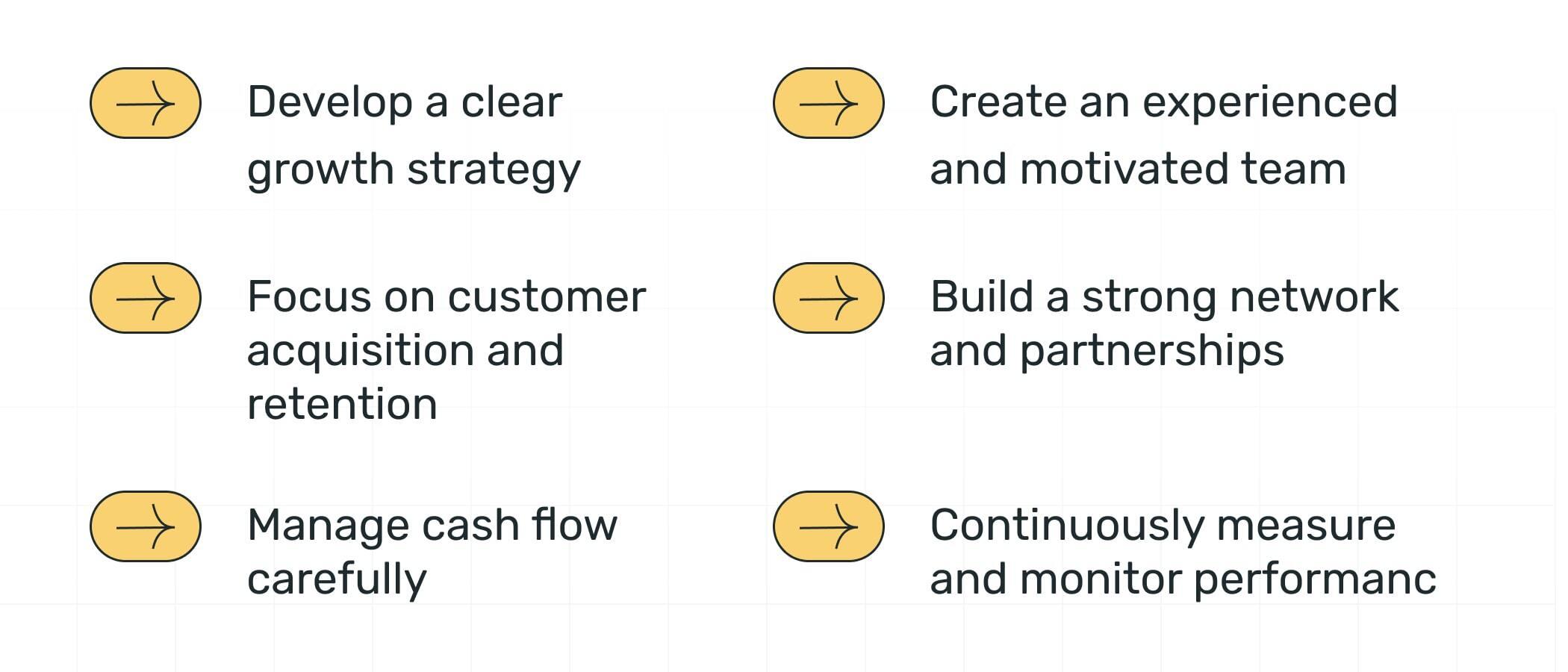
Develop a clear growth strategy
A well-thought-out growth plan is essential for startup scaling. This plan should outline the goals and objectives of the business, as well as the strategies and tactics to achieve them. It should also take into account the resources and capabilities of the business, as well as the competitive landscape.
“This strategy ought to be adaptable enough to accommodate shifts in the business environment or the market, while also being transparent enough to outline a path forward for expansion.”
— James White, Managing Director of Media First
Discovery phase is an excellent option to create a thorough and precise growth plan for your startup. Learn more in our extensive guide about the discovery phase.
Create an experienced and motivated team
As your startup grows, it will become increasingly important to have a team with a relevant and strong skill set that supports your values. So, from the very beginning, you should make sure you hire the right people.
“My advice to other startups looking to scale is to focus on building a strong team that helps propel the business forward. Scaling cannot be effective without the support of a talented workforce whose goals and ambitions align with the company’s objectives.
To create a strong team, entrepreneurs need to focus on building an inclusive, innovative, and empowering culture that compels people to excel in their respective roles. Employees also thrive in startups where there is equal access to opportunities for growth and development, as well as fair and equitable compensation and benefits.”
— Arthur Worsley, the Founder of The Art of Living
Focus on customer acquisition and retention
Startups should focus on developing effective marketing and sales strategies that target their ideal customer segments. They should also invest in customer service and support to ensure they provide a great customer experience.
Build a strong network and partnerships
Building partnerships and an extensive network can help startups scale faster and more effectively. These connections can provide access to new markets, customers, and resources that can support growth. You should look for partners who share your values and vision for the business.
“Strategic partnerships can help startups scale their business more quickly by providing access to new markets, customers, and resources.
As an example, we partnered with hospitals in our Mission to ZERO™ campaign. Today, we offer healthcare institutions a solution to some of their biggest hidden problems and that is contamination leading to misdiagnosis of bloodstream infections, including sepsis, which can lead to unnecessary and prolonged antibiotic therapy, and false-positive CLABSIs.”
— Greg Bullington, Co-Founder and CEO of Magnolia Medical Technologies
Manage cash flow carefully
Startups should develop a comprehensive cash flow management plan that takes into account their growth projections and funding needs. You should also look for ways to optimize your cash flow, such as reducing expenses and improving collections.
Continuously measure and monitor performance
To ensure that your growth strategy is working effectively, you need to continuously measure and monitor your startup’s performance. Develop key performance indicators (KPIs) that align with your growth objectives and use data to track progress and make adjustments as needed.
Metrics for measuring startup scaling
When it comes to scaling a startup, it's important to focus on the right metrics to track and analyze growth.
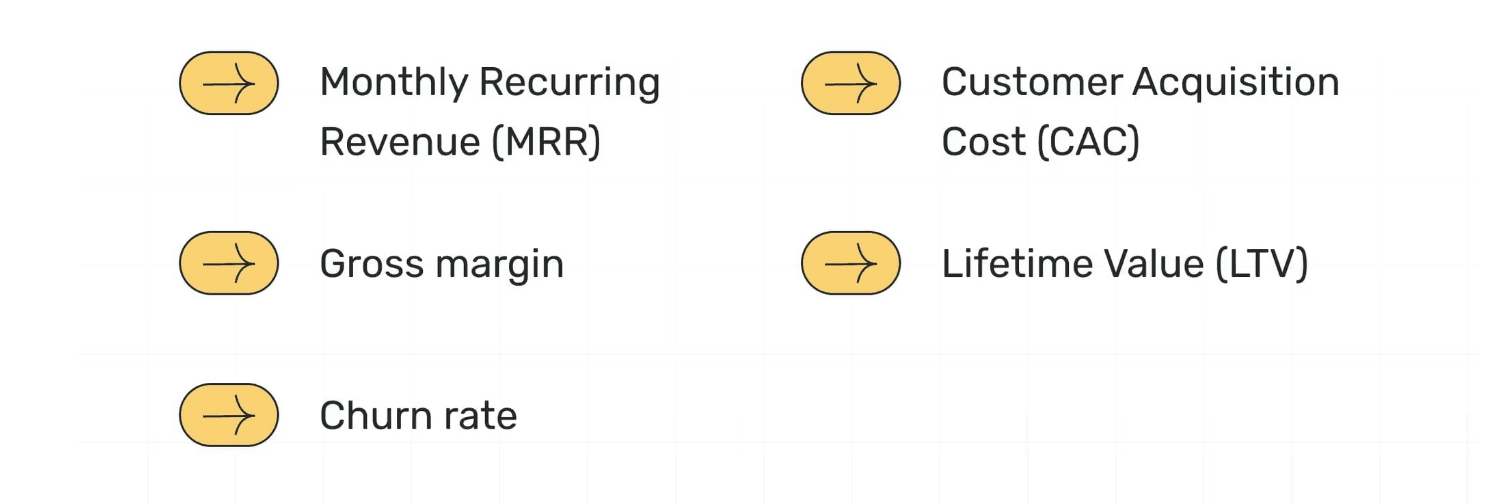
Monthly Recurring Revenue (MRR) is the amount of revenue a startup generates on a monthly basis. This metric is important because it helps to identify trends over time.
Customer Acquisition Cost (CAC) measures the cost of acquiring a new customer, including marketing and sales expenses. It helps to determine the effectiveness of your marketing and sales efforts.
Churn rate measures the rate at which customers stop using your product or service. Churn rate helps to understand how well you are retaining customers and identify areas for improvement.
Gross margin measures the amount of revenue a startup generates after accounting for the cost of goods sold. This metric is important because it helps startups understand their profitability and identify areas where they can reduce costs.
Lifetime Value (LTV) measures the total revenue a startup can expect to generate from a single customer over their lifetime. This metric is important because it helps startups understand the value of their customers and determine how much they can spend on customer acquisition.
To use these metrics effectively, you should analyze the data on a regular basis and use it to inform decisions about scaling your startup.
For example, if a startup's churn rate is high, it may need to focus on improving customer retention before scaling. Similarly, if a startup's CAC is too high, it may need to adjust its marketing and sales strategies to make customer acquisition more cost-effective.
To sum up
Scaling a startup is like trying to navigate a roller coaster blindfolded. It's exhilarating, terrifying, and full of unexpected twists and turns. But unlike a roller coaster, the stakes are much higher when it comes to scaling your startup. The success or failure of your business depends on your ability to grow and adapt to changing market conditions.
However, we believe that it will be an exciting journey if you follow the tips and use the strategies that we mentioned in this article. So, you’ll be in a more safe place as you implement what is proven by other startups.
Subscribe to my newsletter
Read articles from Artsem directly inside your inbox. Subscribe to the newsletter, and don't miss out.
Written by

Artsem
Artsem
SEO specialist at SolveIT. We build custom Mobile & Web products for Startups🚀and SMEs📈, TOP-10 app developers in Poland🏆, Digital Transformation for your business